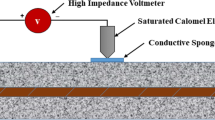Abstract
Corrosion of steel in reinforced concrete structures is a recurrent problem affecting civil engineering structures and costing the world billions of dollars per year. This physical phenomenon mainly results from chloride ingress or concrete carbonation. Corrosion can be diagnosed through a nondestructive method such as half-cell potential measurements. The present paper studies this method on a reinforced concrete wall containing eighteen unconnected steel bars and subjected to chloride-induced macrocell corrosion. Three corrosion systems with different configurations of connections between the steel bars are generated, involving three different anode-to-cathode surface ratios. Then, half-cell potential variations are observed versus macrocell corrosion current. The results lead to a critical discussion regarding the physical relevance of the usual potential threshold method to detect corroding rebars in reinforced concrete structures. In addition, the experiments demonstrate that electrical continuity between reinforcing steel bars is not necessary to get meaningful information about the macrocell corrosion system. At last, the paper show that the electric field (potential gradient) relative to a macrocell corrosion system may be measured by connecting the measurement system (reference electrode + voltmeter) to any electrochemical system in electrolytic contact with the concrete.








Similar content being viewed by others
References
Angst UM (2018) Challenges and opportunities in corrosion of steel in concrete. Mater Struct 51(1):4. https://doi.org/10.1617/s11527-017-1131-6
Liu Y (1996) Modeling the time-to corrosion cracking of the cover concrete in chloride contaminated reinforced concrete structures
Tuutti K (1980) Service life of structures with regard to corrosion of embedded steel. ACI Spec Publ 65:223–236
Zhang R, Castel A, François R (2009) The corrosion pattern of reinforcement and its influence on serviceability of reinforced concrete members in chloride environment. Cem Concr Res 39(11):1077–1086
González JA, Feliú S, Rodríguez P, Ramírez E, Alonso C, Andrade C (1996) Some questions on the corrosion of steel in concrete—Part I : when, how and how much steel corrodes. Mater Struct 29:40–46
Alonso C, Andrade C, González JA (1988) Relation between resistivity and corrosion rate of reinforcements in carbonated mortar made with several cement types. Cem Concr Res 18:687–698
Sohail MG, Laurens S, Deby F, Balayssac JP (2015) Significance of macrocell corrosion of reinforcing steel in partially carbonated concrete: numerical and experimental investigation. Mater Struct 48(1–2):217–233
Marchand J, Laurens S, Protière Y, Samson E (2016) A numerical study of polarization tests applied to corrosion in reinforced concrete. ACI Spec Publ 312:1–12
Recommendation of Rilem TC: 154-EMC (2000) Electrochemical techniques for measuring metallic corrosion—test methods for on-site measurement of resistivity of concrete. American Concr Inst 33:603–611
ASTM C876-09 (2009) Standard test method for corrosion potentials of uncoated reinforcing steel in concrete. ASTM International, West Conshohocken. www.astm.org
Elsener B, Andrade C, Gulikers J, Polder R, Raupach M (2003) Hall-cell potential measurements—potential mapping on reinforced concrete structures. Mater Struct 36(7):461–471
Reichling K, Raupach M, Broomfield J, Gulikers J, L’Hostis V, Kessler S, Osterminski K, Pepenar I, Schneck U, Sergi G, Tache G (2013) Full surface inspection methods regarding reinforcement corrosion of concrete structures. Mater Corros 64(2):116–127
Bertolini L, Elsener B, Pedeferri P, Redaelli E, Polder R (2013) Corrosion of steel in concrete: prevention, diagnosis and repair, 2nd edn. Wiley, New York
Swiss Society of Engineers and Architects (SIA) (2013) Conception, exécution et interpretation de la mesure de potentiel sur des ouvrages en béton armé, Cahier Technique 2006, Edition
Reichling K, Raupach M (2014) Method to determine electrochemical potential gradients without reinforcement connection in concrete structures. Cem Concr Compos 47:3–8
Sadowski L (2013) Methodology for assessing the probability of corrosion in concrete structures on the basis of half-cell potential and concrete resistivity measurements. Sci World J 2013:1–8
Elsener B (2001) Half-cell potential mapping to assess repair work on RC structures. Constr Build Mater 15(2–3):133–139
François R, Arliguie G, Bardy D (1994) Electrode potential measurements of concrete reinforcement for corrosion evaluation. Cem Concr Res 24(3):401–412
François R, Arliguie G (1993) Measurements of electrode potential of concrete reinforcing bars using a bi-electrode system. In: International conference—N.D.T. in Civil Engineering, Liverpool, England
Nakamura E, Watanabe H, Koga H, Nakamura M, Ikawa K (2008) Half-cell potential measurements to assess corrosion risk of reinforcement steels in a PC bridge. In: Binda L, di Prisco M, Felicetti R (eds) RILEM symposium on on site assessment of concrete, masonry and timber structures-SACoMaTiS, pp 109–117
Funding
This study was funded by INSA Toulouse.
Author information
Authors and Affiliations
Corresponding author
Ethics declarations
Conflict of interest
The authors declare that they have no conflict of interest.
Rights and permissions
About this article
Cite this article
Sassine, E., Laurens, S., François, R. et al. A critical discussion on rebar electrical continuity and usual interpretation thresholds in the field of half-cell potential measurements in steel reinforced concrete. Mater Struct 51, 93 (2018). https://doi.org/10.1617/s11527-018-1221-0
Received:
Accepted:
Published:
DOI: https://doi.org/10.1617/s11527-018-1221-0




